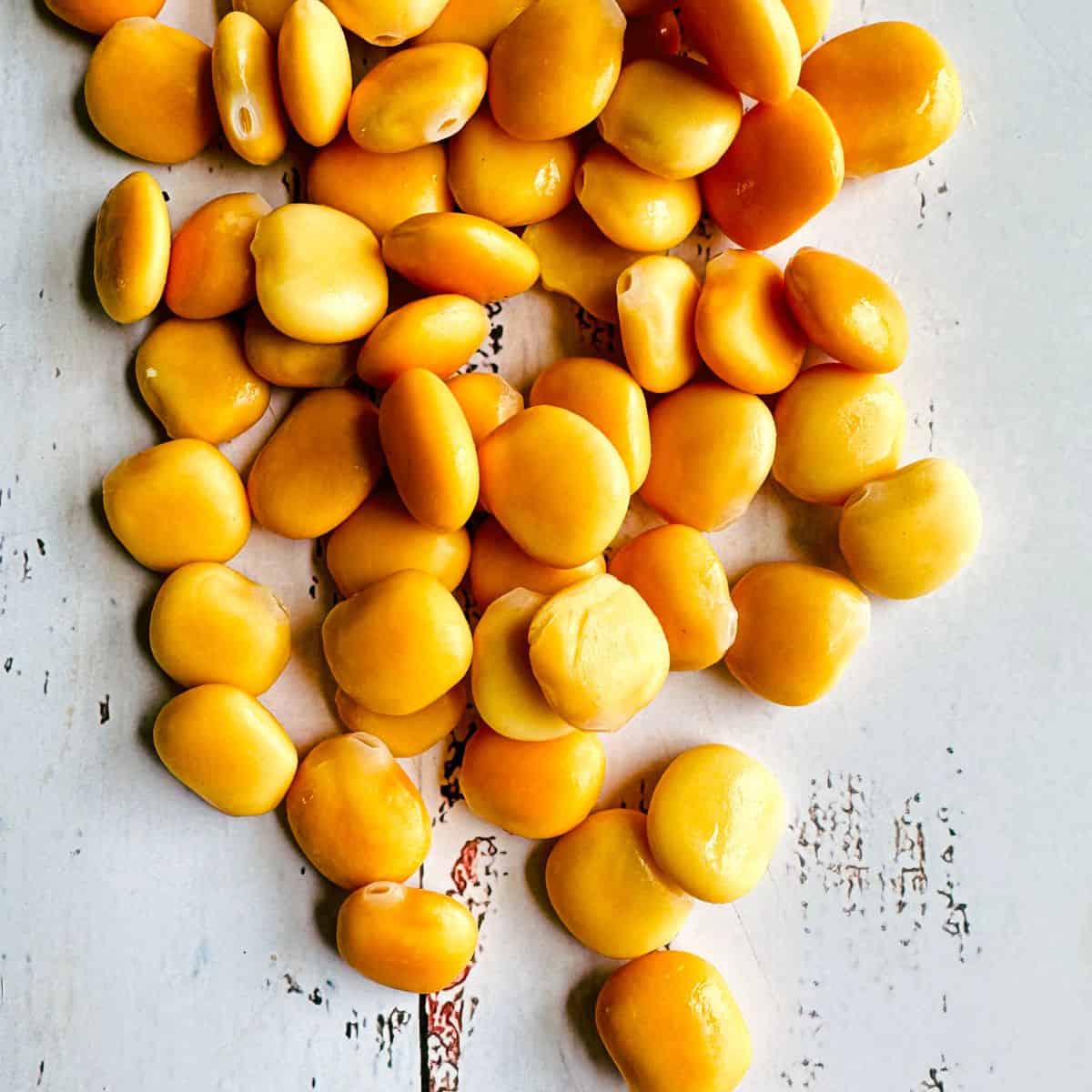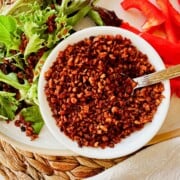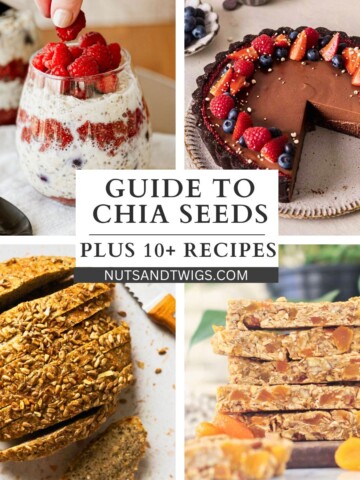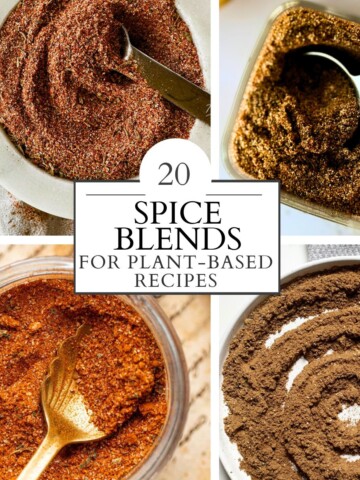Lupini beans, or lupin beans or lupine, are a lesser-known legume gaining popularity due to their exceptional nutritional profile. With an impressive 14 grams of protein and low carbs, this food option also packs a nutritious punch in every 100 grams.

Jump to:
What are Lupini Beans?
Lupini beans are the yellow legume seeds of the genus Lupinus. They're a common snack in Mediterranean countries and are enjoyed in some parts of Northern Africa and South America. The beans have a rich history, dating back to the Roman era.
A fun fact: These beans were a common food for traveling Roman soldiers!

Nutritional Powerhouse
Lupini beans are a nutritional powerhouse packed with essential nutrients that contribute to overall health and well-being.
Here's a breakdown:
- Protein: One of the richest plant protein sources per calorie.
- Fiber: High fiber content that's great for digestion.
- Minerals: Contains minerals like manganese, magnesium, iron, calcium, and potassium.
- Low in Fat: They are low in calories and fats, making them a weight-friendly food.
They are low in carbohydrates making them an excellent choice for those seeking high protein, low carb options.
These beans contain three times more plant protein than quinoa, making them an excellent meat substitute for reducing meat intake.
They are also fiber-rich. This high fiber content contributes to feelings of fullness and aids in weight management.
Here is a chart that offers a quick comparison of the nutritional profiles between lupini beans and other popular plant-based foods. Each of these options provides a distinct combination of protein, calories, carbohydrates, and fiber.
| Food (per 100g) | Protein | Calories | Carbohydrates | Fiber |
|---|---|---|---|---|
| Lupini Beans | 14g | 123 | 11g | 11g |
| Chickpeas | 7g | 139 | 22g | 6g |
| Rolled Oats | 13g | 379 | 68g | 10g |
| Quinoa | 4g | 120 | 21g | 3g |

Health Benefits
Weight Loss
One of the significant benefits of lupini beans is their potential for weight loss. Due to their high protein and fiber content, these beans are incredibly filling, which can help curb appetite and prevent overeating. Including them in your diet can contribute to a calorie deficit, making it easier to achieve weight loss goals.
The low starch content of lupini beans also makes them an excellent choice for those following a low-carbohydrate diet.
Improved Digestion
Lupini beans are rich in prebiotic soluble fiber, which acts as food for the beneficial bacteria in the gut. This fiber promotes a healthy digestive system, aids in regular bowel movements, and helps prevent digestive problems such as constipation and irritable bowel syndrome. Consuming them regularly can contribute to optimal gut health and improve overall digestion.
Heart Health
Lupini beans are considered a "cardioprotective" food, meaning they promote heart health. The high fiber content of these beans helps lower cholesterol levels, reducing the risk of heart disease. Lupini beans also contain oligosaccharides, which have been shown to have cardioprotective benefits. Including them in a fiber-rich diet can support long-term cardiovascular health and wellness.
Skin Health
The nutrients in lupini beans, such as vitamins C, E, and K, and minerals like zinc and selenium, contribute to healthy skin. These antioxidants help protect the skin from free radical damage, which can lead to premature aging and skin disorders. Additionally, the high protein content supports collagen production, a protein essential for maintaining skin elasticity and firmness.
What Diets Can Include Lupini Beans?
Lupini beans are a nutritious and adaptable food that can complement various dietary preferences and nutritional needs. Whether following a specific diet plan or aiming for a balanced and healthy eating pattern, these beans can be a great addition.
- High-Protein Diets: With their rich protein content, these beans are an excellent choice for those seeking to increase their protein intake.
- Low-Carb and Keto Diets: Containing a small amount of carbs, and zero net carbs, these beans are a suitable option for low-carb and ketogenic diets, where keeping carbohydrate intake minimal is crucial.
- Gluten-Free Diets: They are naturally gluten-free as a legume, making them a safe option for those with gluten sensitivities or celiac disease.
- Mediterranean Diet: As a traditional food in the Mediterranean region, Lupini beans fit perfectly into the Mediterranean diet, known for its heart-healthy focus on plant-based foods, healthy fats, and whole grains.
- High-Fiber Diets: Rich in dietary fiber, these beans support digestive health and can be an excellent addition to diets aiming to increase fiber intake.
- Weight Management Diets: Their combination of protein and fiber helps with satiety, potentially aiding in weight management by reducing hunger and supporting portion control.

Cooking with Lupini Beans
If you buy jarred or canned lupini beans, they've been pre-treated to remove the bitterness, so you can enjoy them immediately.
However buying dry lupini beans will require proper soaking and preparation before consumption to remove bitter alkaloid compounds. These compounds can be toxic if not adequately removed.

The bitterness isn't something that will go away with just regular cooking, either. That's why there's a specific process to prepare them, designed to remove the bitterness:
Soaking and Preparation
- Soak: You'll need to soak dried lupini beans in water for several hours or overnight.
- Boil: After soaking, you'll boil them in fresh water for about an hour or more, depending on the beans.
- Rinse and Repeat: Now comes the crucial part. You'll need to soak the beans in cold water, changing the water at least once a day for up to a week! It's this prolonged soaking that draws out the bitter compounds.
- Taste Test: After several days of soaking and changing water, you can taste a bean to see if the bitterness is gone. If it's still bitter, continue soaking and changing the water.
- Season: Once the bitterness is gone, you can season the beans with salt or other flavors. Some people enjoy them pickled with vinegar and herbs.
It's quite the process, but the beans become a nutty, slightly earthy snack or addition to various dishes you will love. If you make a large batch, you can see below for storage ideas.

How to Store Lupini Beans
Storing these beans properly is key to maintaining their freshness and taste, whether they're dried, cooked, or in a jar. Let's break it down into each form:

Dried
- Before Soaking: Store them in an airtight container in a cool, dark place like your pantry. This will keep them fresh for up to a year or even longer.
- After Soaking but Before Cooking: If you've soaked them but aren't ready to cook, refrigerate them in the soaking water for 2-3 days.
Cooked (After Removing Bitterness)
- Short Term: Once cooked and the bitterness has been removed, you can store them in a covered container in the fridge for up to a week. If you've seasoned them with salt or vinegar, that might extend their life.
- Long Term: You can also freeze cooked lupini beans. Place them in an airtight container or a freezer-safe bag, and they'll last up to six months in the freezer. Just thaw and reheat when you're ready to use them.
Jarred or Canned
- Unopened: These can be stored in the pantry like any canned goods until the expiration date on the jar or can.
- Opened: If you've opened a jar and haven't used all the beans, transfer the remaining beans and liquid into an airtight container and refrigerate. They should last about a week.
- Pickling: If you make a big batch of pickled lupini beans, you can store them in vinegar brine in the fridge. They'll last several weeks, and the flavor will improve over time!
Where to Find Lupini Beans
You might find lupini beans either dried or jarred. The dried version will require that soaking and cooking process I mentioned earlier, while the jarred ones are typically ready to eat. Here are some places you might be able to find them.
- Local Italian or Mediterranean Markets: These specialty stores often carry lupini beans, especially in the jarred or pickled form.
- Health Food Stores: With their nutritional profile, lupini beans might be found at stores specializing in health foods. Places like Whole Foods or local health-focused markets in your area are good places to check.
- Online Retailers: Websites like Amazon, Thrive Market, or other online specialty food shops could have various forms of lupini beans. This is a convenient option if you're having trouble finding them locally.
- Farmers Markets: If you're lucky, local farmers or vendors may sell lupini beans at farmers markets. It's a bit of a long shot but always an exciting find if you spot them!
- Big Chain Supermarkets: Some larger supermarkets might carry them in the international or specialty food aisles. Brands like Cento and Bartolini often package lupini beans, so look for those names.
Incorporating Lupini Beans into Your Diet
There are various ways to incorporate lupini beans into your diet, allowing you to enjoy their nutritional benefits in different forms. Here are a few ideas:
- Snack on Whole Lupini Beans: These beans can be enjoyed as a snack, similar to roasted nuts. You can purchase pre-cooked lupini beans in brine and eat them directly from the jar or bag. They make a convenient and nutritious snack option.
- Add Lupini Flour to Baked Goods: Lupini flour, made from ground lupini beans, can be used as a substitute for regular flour in baking. It adds a protein and fiber boost to baked goods while reducing the overall carbohydrate content.
- Include them in Salads: Lupini beans can be added to salads to provide a protein-rich component. They can be mixed with fresh vegetables, herbs, and a flavorful dressing to create a delicious and nutritious salad.
- Use Lupini Beans in Soups and Stews: They can be added to soups and stews as a hearty and nutritious ingredient.
For delicious recipes with lupini beans, visit lupini bean seitan, high-protein lupini bean hummus, and high-protein tofu scramble.
Takeaways
Lupini beans are emerging as a rising star in the legume world due to their exceptional nutritional profile and health benefits.
These beans are a great source of plant protein, fiber, and essential minerals, making them an excellent addition to a healthy diet.
Whether you enjoy them as a snack, incorporate them into baked goods, or use them in salads and soups, lupini beans offer a versatile and nutritious option for various recipes.
With their potential for weight loss, improved digestion, heart health, and skin benefits, lupini beans are worth exploring as a valuable addition to your diet. So give lupini beans a try and experience the many benefits they offer.

















sandra phillips says
I cant afford Lupinie beans, so, can you tell me a canned bean substitute, and do I drain the liquid ,if using canned beans? I use the cup meaurements nor grams, thank you very much!
Regi Pearce says
Hi Sandra! Thanks for checking out the All About Lupini Beans post. I have two recipes that use lupini beans on the site - the Lupini Bean Seitan and the Lupini Bean Hummus recipe. The lupini beans in either recipe can be substituted with a white bean like chick peas. In the original Lupini Seitan Recipe from Fit Vegan Chef, she has used edamame as a substitute and said it worked as well but I have not tried it. Just remember the macros and nutritional profile will change but you'll get similar taste and results. Hope that helps.